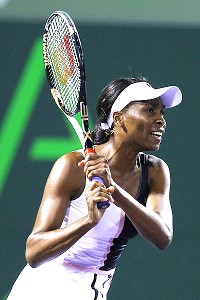KEY BISCAYNE, Fla. -- The storylines coming into this star-stuffed Sony Ericsson Open were Victoria Azarenka's phenomenal winning streak and the resurgence of Roger Federer.
Well, the great Swiss champion is gone from the tournament and Azarenka is lucky to be hanging around. They were completely upstaged by a retro blast from the deep, distant American past.
Between 1999 and 2004, Venus and Serena Williams and Andy Roddick won this event six times among them. They've all won Grand Slam singles titles and reached the No. 1 ranking, but lately it's been tough sledding. Venus, 31; Serena, 30; and Roddick, who turns 30 in August, have been showing their age the past few years.
But, for some reason, this past week they looked like kids in a sweet shop, bouncing around on a Skittles sugar high. Serena and Venus played their way into the quarterfinals here, and it was Roddick who stunned Federer in the third round.
Hey, maybe the Spanish explorer Juan Ponce de Leon had it right when he inadvertently discovered Florida in 1513. Nearly 500 years later, you have to wonder if he should have been looking for the fountain of youth a little closer to Miami.
Tuesday, however, brought a sobering case of reality. Nostalgia -- and you know this if you have seen the new Van Halen tour -- can be overrated.
Roddick, still struggling after a hamstring injury, hit the wall against the higher-seeded Juan Monaco, losing 7-5, 6-0. In the first evening match, in something of a surprise, Serena fell to No. 4 seed Caroline Wozniacki 6-4, 6-4.
"This was special," Wozniacki said in her courtside interview. "I'm so excited. She is a great champion."
From the beginning, Serena seemed out of sorts. She was broken in the third game and although she pressured Wozniacki, particularly in the three-deuce eighth game, the 21-year-old Dane did not fold. In the second set, Wozniacki again broke Serena in the third game. Down 3-1, Serena was broken again when Wozniacki successfully challenged a call that would have leveled the fifth game at deuce.
Serena made it interesting, breaking Wozniacki at 2-5 -- for the first time -- but couldn't do it again. Two points from leveling the second set at 5-all, Serena sprayed a backhand service return long and netted another backhand to give Wozniacki the match.
"I struggled with errors," said Serena, who was credited with 36 of the unforced variety. "I don't think she was a nightmare to play. I was fine. I just probably needed to make a few more shots."
Besides her boyfriend, golfer Rory McIlroy -- who was in the stands -- Wozniacki is most notable for the 67 weeks she spent as the WTA's No. 1 player. And for failing to win a Grand Slam singles title.
Now that's she has fallen below the radar, to No. 6, the pressure seems to be off. Her defensive-dominated game is starting to evolve. Against Serena, she went for her serves (she was out-aced only 4-3) and was more aggressive from the baseline. Late in the match, she even started throwing down a few fist pumps.
"I think she served the best she's served in her career," a subdued Serena said. "She knows in order to hang out, she needs to serve bigger."
[+] Enlarge

Al Bello/Getty ImagesWho needs practice anyway? Venus Williams is the lone American women remaining at the Sony Ericsson Open.
This felt like a distinct shift in the status quo; Wozniacki beat Serena for the first time in four tries. She next plays No. 2 seed Maria Sharapova in Thursday's semifinals.
With all due respect to Roddick's well-deserved victory, the story of the tournament is American tennis' senior citizen, Venus Williams.
Time was when she could blow into an event with no matches under her belt and rip through the draw on adrenaline and muscle memory. But, after rebuilding her body after wrestling with an energy-sapping autoimmune disease, she arrived here with zero WTA matches played in 2012. It had been seven months since she pulled out in the second round of the U.S. Open.
Wednesday, when she meets Agnieszka Radwanska, Venus will step on the court as one of just two undefeated players in the world. Granted, 4-0 doesn't begin to compare to Victoria Azarenka's 26-0, but consider the quality of her (unlikely) wins.
After a routine first-round win over Kimiko Date-Krumm, Venus took down world No. 3 Petra Kvitova in three sets. In the final frame, when you might have thought she'd have been fatigued, Venus pitched a 6-0 shutout. In the third set against 24-year-old Canadian Aleksandra Wozniack, Venus pulled out a tiebreaker victory. In her third three-set match in four days, she prevailed over former No. 1-ranked Ana Ivanovic on Monday night, 6-7 (4), 6-2, 6-2.
After she spent 7 hours and 35 minutes on the court in her past three matches, however, it's valid to wonder if Venus will have anything left for Radwanska, a crafty player who knows how to extend points.
"I come out on court knowing I can play well, but with almost no expectations," said Venus, who hit 13 aces. "It means so much to me to win. You never know what each day will bring."
Written by and all credit goes to:
Greg Garber
Written by and all credit goes to:
Greg Garber

